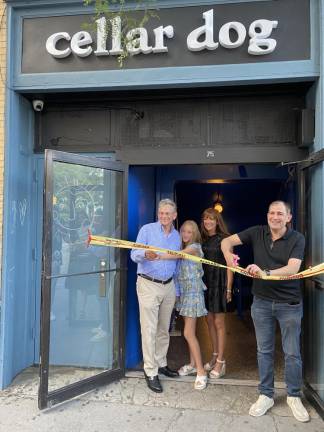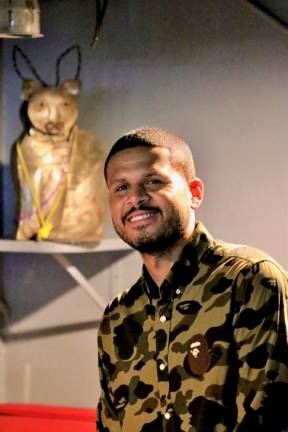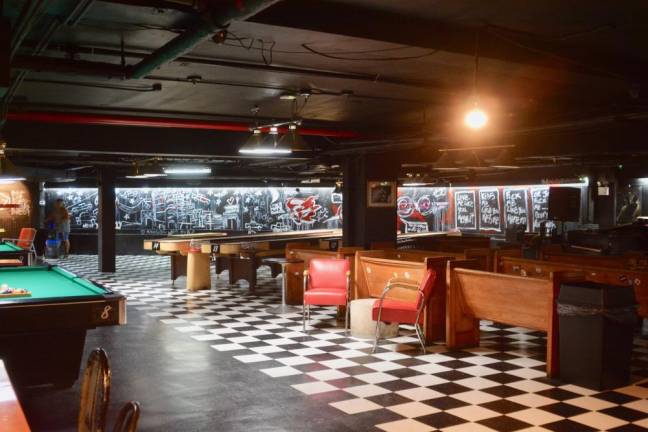From Fat Cat to Cellar Dog
General manager Eric Hernandez on reopening the iconic West Village venue, the nightlife landmark’s storied past and its exciting future
When it came time to reopen the former Fat Cat — the legendary live music and game hall that illuminated 75 Christopher Street and closed at the start of COVID — the experienced team behind the relaunch as Cellar Dog worked to maintain the eclectic atmosphere set by its predecessor, while adding some necessary updates.
The revitalized and one-of-a-kind establishment’s dedicated general manager Eric Hernandez spoke with us hours before their opening night on June 30. The Queens native, who got his start in the industry in high school, is grateful that he’s able to be a part of the city’s history by not only reopening an iconic Manhattan venue, but also taking on this labor of love during a pandemic. The 30-year-old has been in this business for close to 15 years, and teamed up with Arthur Backal, CEO of Backal Hospitality Group, the co-owner behind this new venture, when he worked at another legendary spot, Madison Square Garden.
As for the traditions they kept from the original space, revelers will still be watching live jazz, complete with the old setup of church pews in front of the stage, which will welcome celebrated musicians every night. And it will still have the same game hall feel, with patrons shooting pool and playing ping pong, shuffleboard, foosball, checkers and chess at the same exact tables that stood in the old bar. And as for what changed, while Fat Cat only had peanuts and chips, and allowed outdoor food to be brought in, Hernandez worked with BHG’s culinary director and executive team to create a “very simple, approachable menu” with fun bite-sized treats like nachos, grandma pizza, and of course, in keeping with its name, “a really cool hot dog option.”
When asked what he imagines the crowd there to be like, he said, “bridge and tunnel people, suit and ties from FiDi, but you’re also going to get the West Village, the people that are jamming out on the corners.”
How did you get into the hospitality industry?
I got into the hospitality industry, I would have to say, in the middle of high school. That portion of my life where I was doing a little bit of finding out how to financially be stable for yourself. And the hospitality industry has got to be probably the number one welcoming industry when it comes to a fresh-faced kid coming out of high school. So I got my start in Times Square at John’s Pizzeria. And I was their host there. What an incredible place that was. And it just sucked me into this hospitality vortex and it was just incredible dealing with people and being at the top of my list of favorite pastimes of life, human interaction ... with absolute strangers. And the good thing about it was in Times Square we were dealing with people from all over the world. Fortunately, in New York City, kind of anywhere you are you kind of get that, but in Times Square, that’s amplified so much.
What was it like to work on opening a bar during a pandemic?
Oh, it was absolutely challenging. Dealing with, of course, all the restrictions that we were all going through and trying to maneuver around... Not to mention, absolutely anything that you would ever try to order — from food and beverage, paper goods, electronics — everything was so backordered, [there were] shipping and manufacturing delays. Overall, just challenges across the board, but it’s very gratifying to come out on the other side of it and actually have our doors opening tonight. It’s just pretty magical and I’m really glad that I was able to be a part of it.
With restaurants now facing staffing difficulties, how did you manage to find your employees?
Working with Arthur Backal and Backal Hospitality, it’s amazing to have a portfolio with multiple properties, one [Versa Rooftop & Restaurant] of which I also used to manage. And I wanted to go into our familiar staff members that we worked with in the past. So what we did is we kind of vetted them out to see who was available, who didn’t leave the city during these trying times or relocate back to their original state and or took a leap of faith and went elsewhere, which is totally understandable. For the individuals that did stay, we wanted to sit down, gather their thoughts, see where they were personally and professionally and see if there was a fit with the new direction ... And we were fortunate enough to get some of our candidates that understand our working style and expectations. I think that was very crucial, being able to open tonight. Not to say that our staff didn’t have to get acclimated and trained, which is inevitable, but it’s that much more comfortable and simpler when you have people that are familiar with not only their colleagues, but the ownership and management... BHG is just one massive family, which is incredible.
Tell us what Fat Cat was like and how you’re honoring its tradition with Cellar Dog.
Fat Cat was an absolute landmark, to say the least. The place has an incredible track record and reputation for being one of the truest live jazz-billiards bars in not only the West Village, but in all of Manhattan. It was dated. It was a very true-to-itself place, where I’m sure all the up-keeping was taken care of in-house. I’m sure some corners were cut here and there just to have small solutions, not thinking long-term. In their defense, for how much volume they were doing — I’m not saying it was a hundred percent understandable — but I see the angle.
But what we did when we came in here was, we wanted to obviously clean it up and give it a cosmetic facelift. We took care of new flooring throughout the entire 9,000 square-foot venue. Everything was repainted ... And then we installed this lovely mural [created by artist Domingo Zapata] that takes up probably around 300 feet of the back wall. Of course, the bathrooms were probably the biggest renovation for us. Fat Cat was unfortunately notoriously known for a really, really terrible bathroom setup. Some stalls didn’t have doors. It was just not maintained as well as I’m sure they would have liked or the patrons would have appreciated. So that was a huge focal point for us to make sure that our guests can be absolutely comfortable in a restroom environment. We installed a gender neutral and an ADA wheelchair-accessible restroom as well. That was really important from an inclusivity perspective. We want to make sure everybody is welcome here.
What did you keep from the old space?
If you walk in here, you’re going to recognize and feel like you’re still at Fat Cat. Because we kept the original church pews in front of the live jazz area. All of the game tables are pretty much the same. The shuffleboard tables are all the same from the original establishment. Same with the pool tables, we just re-felted them to bring them back to life from a color and functionality perspective. The floor was altered, but you still have your same heavy, black columns near the live music area that everybody was very familiar with. The original construction of the bar wasn’t altered at all. It’s almost in its truest form, it just had an insanely beautiful makeover.
Tell us how you came up with the menu.
Our director of culinary at BHG, Gerron Douglas, alongside Arthur Backal, Allen Atwell [Vice President of Operations and Strategy for BHG] and myself, constructed a very simple, approachable menu for Cellar Dog. Originally, Fat Cat only had assorted peanuts and kettle chips — a super snack-friendly place. And it allowed outside dining, so they gave people takeout menus and they ordered, which is actually really cool, in my opinion. Arthur Backal sees hospitality all the way though and his perspective was that there’s no reason why we shouldn’t be able to offer food to our guests. But we also didn’t want to reinvent the wheel ... and build a kitchen down here.
www.cellardog.net


